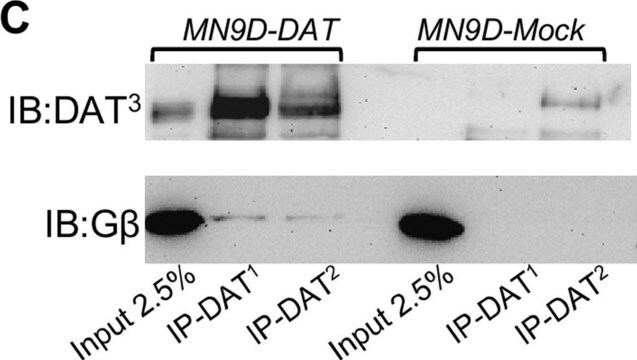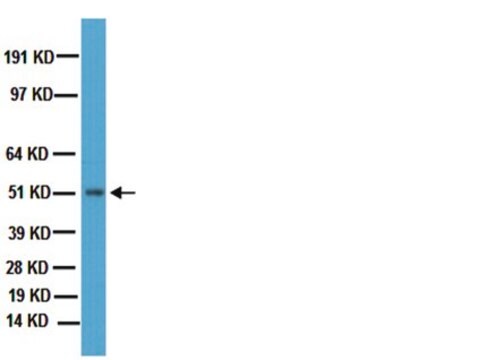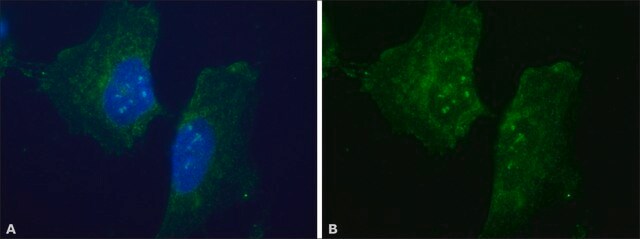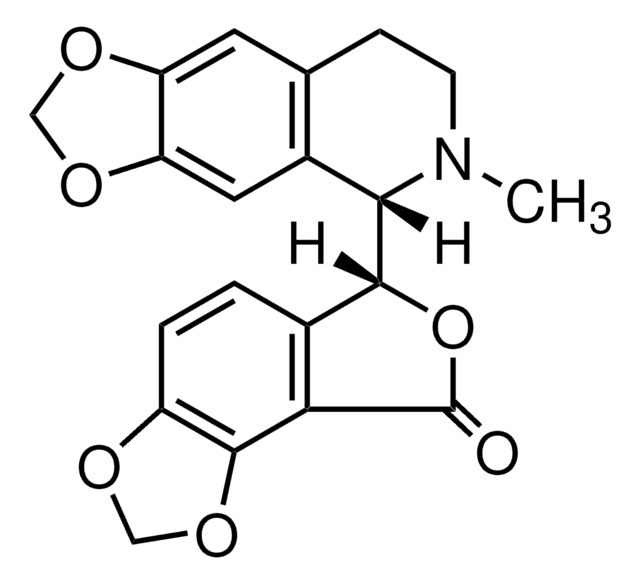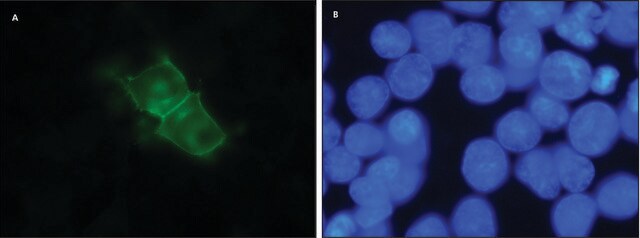MAB5300
Przeciwciało przeciw dopaminie, klon K56A
clone K56A, Chemicon®, from mouse
About This Item
Polecane produkty
pochodzenie biologiczne
mouse
Poziom jakości
forma przeciwciała
purified immunoglobulin
rodzaj przeciwciała
primary antibodies
klon
K56A, monoclonal
reaktywność gatunkowa
rat
producent / nazwa handlowa
Chemicon®
metody
immunohistochemistry: suitable
izotyp
IgG
Warunki transportu
dry ice
docelowa modyfikacja potranslacyjna
unmodified
informacje o genach
rat ... Slc6A3(24898)
Specyficzność
Reaktywność krzyżową określono za pomocą testu ELISA poprzez eksperymenty konkurencji z następującymi związkami:
Związek Reaktywność krzyżowa
Dopamina-G-BSA 1
L-DOPA-G-BSA 1/10,000
Tyrozyna-G-BSA 1/36,000
Tyramina-G-BSA 1/>50,000
Noradrenalina-G-BSA 1/>50,000
Oktopamina-G-BSA 1/>50,000
Adrenalina-G-BSA 1/>50,000
Dopamina 1/>50,000
Skróty:
(G) Glutaraldehyd
(BSA) Albumina surowicy bydlęcej
Immunogen
Zastosowanie
Optymalne rozcieńczenia robocze muszą zostać określone przez użytkownika końcowego.
PROTOKÓŁ wykrywania dopaminy metodą immunohistochemiczną/cytochemiczną. Przykład dla mózgu szczura.
1. ROZTWORY DO PRZYGOTOWANIA - Roztwory należy przygotować w zależności od potrzeb.
Roztwór A: 0,1M kakodylan, 10g/L metabisiarczyn sodu, pH 6,2.
Roztwór B: 0,1M kakodylanu, 10g/L metabisiarczynu sodu, 3-5% aldehydu glutarowego, pH 7,5.
2. PERFUZJA SZCZURA - Szczur jest znieczulany pentobarbitalem sodu lub Nembutalem i perfundowany wewnątrzsercowo przez aortę za pomocą pompy z roztworem A (30 ml): 150-300 ml/min, roztworem B (500 ml): 150-300 ml/min.
3. POST FIXATION: 15 do 30 minut w roztworze B, a następnie 4 płukania w 0,05M Tris z 8,5 g/L metabisiarczynem sodu, pH 7,5 (roztwór C).
4. SKROJENIE TKANKI: Można użyć skrawków z wibrotomu lub kriostatu.
5. ETAP REDUKCJI: Skrawki są redukowane roztworem C zawierającym 0,1M borohydryku sodu przez 10 minut. Skrawki są płukane 4 razy w roztworze C bez borohydratu sodu.
6. ZASTOSOWANIE PRZECIWCIAŁA DOPAMINY: Użyć końcowego rozcieńczenia 1:2,500-1:10,000 w roztworze C zawierającym 0,1% Triton X100 i 2% surowicy niespecyficznej. Inkubować 12 skrawków na 2 ml rozcieńczonego przeciwciała przez noc w temperaturze +4°C. Następnie płukać skrawki trzy razy po 10 minut w roztworze C. (Należy pamiętać, że przeciwciało może być użyteczne w wyższym rozcieńczeniu. Należy to sprawdzić, aby zminimalizować możliwość wystąpienia wysokiego tła. Ponadto należy pamiętać, że zmiana systemu buforowania, jak wskazano w protokole, może zmienić tło i rozpoznawanie przeciwciała). Specyficzna reakcja jest następnie ujawniana przez procedurę PAP.
6. DRUGIE PRZECIWCIAŁO: Inkubować skrawki z rozcieńczeniem 1:50 do 1:200 koziego przeciwciała anty-króliczego w roztworze B zawierającym 1% niespecyficznej surowicy przez 3 godziny w temperaturze 20°C lub 2 godziny w temperaturze 37°C. Następnie przepłukać skrawki 3 razy po 10 minut roztworem B.
7. PAP: Inkubować skrawki z odpowiednim rozcieńczeniem antyperoksydazy peroksydazowej (dla metody free floating) w roztworze B zawierającym 1% niespecyficznej surowicy przez 1-2 godziny w temperaturze 37°C. Następnie płukać skrawki 3 razy po 10 minut w roztworze B.
8. WIZUALIZACJA: Kompleksy antygen-przeciwciało są wizualizowane przy użyciu DAB-4-HCl (25 mg/100 mL) (lub innego chromogenu) w 0,05M Tris i filtrowane; dodawany jest 0,05% nadtlenek wodoru. Inkubować skrawki przez 10 minut w temperaturze pokojowej. Zatrzymać reakcję, przenosząc skrawki do 5 ml 0,05M Tris. Przemyć tkankę roztworem D stosując 2, 10-minutowe płukania. Zamontować skrawki na szkiełkach pokrytych chromem i aluminium. Suszyć przez noc w temperaturze 37°C. Nawodnić skrawki stosując konwencjonalne procedury histologiczne. Nałożyć szkiełko nakrywkowe przy użyciu środków do szybkiego montażu.
Wyłącznie do użytku badawczego; nie do użytku diagnostycznego.
Neuroscience
Neurotransmitters & Receptors
Postać fizyczna
Przechowywanie i stabilność
Informacje prawne
Oświadczenie o zrzeczeniu się odpowiedzialności
Nie możesz znaleźć właściwego produktu?
Wypróbuj nasz Narzędzie selektora produktów.
Kod klasy składowania
12 - Non Combustible Liquids
Klasa zagrożenia wodnego (WGK)
WGK 2
Temperatura zapłonu (°F)
Not applicable
Temperatura zapłonu (°C)
Not applicable
Certyfikaty analizy (CoA)
Poszukaj Certyfikaty analizy (CoA), wpisując numer partii/serii produktów. Numery serii i partii można znaleźć na etykiecie produktu po słowach „seria” lub „partia”.
Masz już ten produkt?
Dokumenty związane z niedawno zakupionymi produktami zostały zamieszczone w Bibliotece dokumentów.
Nasz zespół naukowców ma doświadczenie we wszystkich obszarach badań, w tym w naukach przyrodniczych, materiałoznawstwie, syntezie chemicznej, chromatografii, analityce i wielu innych dziedzinach.
Skontaktuj się z zespołem ds. pomocy technicznej